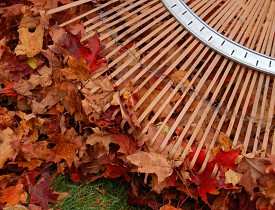Lasagna for Your Lawn and Other Ways to Prep Your Soil for Winter
 For many people, winter is the time to let the vegetable garden hibernate until spring. It's also a great opportunity to naturally and easily build soil structure and fecundity. Healthy soil is the pillar of a productive garden. If improving your soil for spring planting is something you'd like to do, then right now is the time to start. Find out how.
For many people, winter is the time to let the vegetable garden hibernate until spring. It's also a great opportunity to naturally and easily build soil structure and fecundity. Healthy soil is the pillar of a productive garden. If improving your soil for spring planting is something you'd like to do, then right now is the time to start. Find out how.
Plant Winter Wheat and Rye or Other Cold Tolerant Groundcovers
How it helps: Winter wheat and rye are helpful green manure crops, in addition to being traditional food crops. However, a "green manure" or cover crop is grown strictly for the benefit of the soil and is plowed under rather than harvested. Winter wheat and rye grow fast even in cold temperatures (rye, for instance, can germinate down to 35°F), improve soil structure with their roots, and help prevent runoff of topsoil. They also reduce weed growth in the rainy season.
How to use them: Plant winter wheat and rye now as winter cover crops. They can survive even beneath snow and should be plowed under in the spring, adding valuable organic matter back into your soil. Other winter cover crops more suited to mild winter regions are oats, hairy vetch, and crimson clover. Seeds can be purchased from farm and seed supply companies like Seeds of Change.
Lay Down Compost Under Mulch (AKA "The Lasagna Method")
How it helps: The fall is a great time to apply the “lasagna method” of compost integration to your garden. This encourages worms to come up into your top layers, break down compost, and pull it down into your soil to create rich, deep topsoil. This method adds organic matter and nutrients to your soil and prevents runoff of topsoil. By springtime, the compost should be broken down and ready to grow. (If by spring the compost has not decomposed satisfactorily, you can create pockets where you'll be planting crops and fill those pockets with garden soil or fully decomposed compost.)
How to do it: Lay down a layer of fresh or not-fully-ripened compost over your soil (this could be vegetable scraps from the kitchen, coffee grinds, grass clippings, etc.). Add a thin layer of newspapers or plain cardboard over that, then more of the same compost, then a natural mulch like straw or leaves. This time of year, fallen leaves are abundant, free and come highly recommended by syndicated gardening radio host Walter Reeves, the Georgia Gardener, on Hometalk.com. The mulch layer should be thick enough so that none of the compost is visible.
What Not to Do
Do not leave your soil bare over winter. Exposure to the elements over the winter will wash away valuable topsoil, leach the good stuff out of the soil, allow weeds to flourish, and degenerate soil structure. In order to avoid this, you can at least cover your soil with mulch. Natural mulches like straw, leaves, wood chips, and sawdust work great. You might also use cardboard, newspapers, landscaping fabric, and other synthetic mulches, which are better than leaving bare soil.
Do not spread fertilizer or manure on bare ground in the fall or winter, as it is likely to be washed away by winter and spring rains. Fertilizer runoff from industrial farms is actually one of the primary causes of oceanic dead zones around the world, including the dead zone in the Gulf of Mexico. However, integrating aged manure into the lasagna method mentioned above so that it is mixed with compost and then covered with mulch is recommended.
For help with winterizing your garden, contact a professional landscaper.
Jordan Laio is a Networx writer.
Updated September 4, 2018.
Looking for a Pro? Call us (866) 441-6648

Landscaping Average Costs
Landscapers Experiences

Don’t Be A Goober – Hire Qualified Pros For Safe Tree Removal

Tree Removal And Backyard Cleanup Make A New House Feel Like Home



